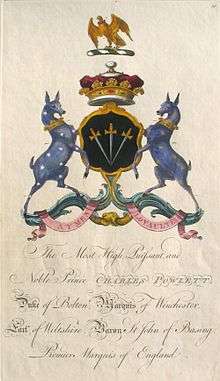Charles Powlett, 5th Duke of Bolton
Charles Powlett, 5th Duke of Bolton KB PC (c. 1718 – 5 July 1765), styled Marquess of Winchester from 1754 to 1759, was a British soldier, nobleman and Whig politician. He was the eldest son of Harry Powlett, 4th Duke of Bolton and Catherine Parry.

Educated at Winchester, he joined the British Army and became a lieutenant-colonel in 1745. Powlett was a Groom of the Bedchamber to Frederick, Prince of Wales from 1749 until the Prince's death in 1751. He had been promoted lieutenant general by 12 March 1752, when he was made a KB. Upon the succession of his father to the Dukedom in December 1754, he became known as Marquess of Winchester,[1] and he left his seat at Lymington to succeed his father in Hampshire. He would remain member for that county until his succession as Duke of Bolton in 1759. On 22 December 1758, he was sworn of the Privy Council.
On 5 July 1765, Bolton died by suicide - shooting himself in the head with a pistol in his house in Grosvenor Square; "nobody knows why or wherefore," wrote Horace Walpole, "except that there is a good deal of madness in the blood".[2] Unmarried, he left most of his fortune to his illegitimate daughter, Jean Mary Browne-Powlett (c.1751–1814), who married Thomas Orde-Powlett, 1st Baron Bolton. He was succeeded in the Dukedom by his brother Harry.
Grosvenor Square
Lord Nassau Powlett, son of 2nd Duke of Bolton, had No 24 (formerly no 21), 1735–38, and the 3rd duke, and then his widow, had No 1, 1753–55. The 5th duke had No. 37 (formerly no 32) from 1759–65. For him it was extensively altered c. 1761–5 by John Vardy, (demolished in 1934).[3] Following the 5th duke Bolton the lease holders or occupiers were the 3rd Duke of Grafton, Prime Minister, 1765; 4th Earl of Tankerville, 1769–79; Baron Alvensleben, Hanoverian Minister, c. 1780–92; 6th Duke of Bolton, 'for tenants', c. 1793–5.[4]
References
- George Edward Cokayne, ed. Vicary Gibbs, The Complete Peerage, vol. II, p. 214, The St Catherine Press, London, 1912
- Walpole, Horace (1844). Letters of Horace Walpole, earl of Orford. 1. Lea & Blanchard. p. 133. Retrieved 30 June 2011.
- 'In 1781 there was one water closet, hung with green flock paper and equipped with what was called a 'Mahogany Watercloset with Bason and Handles Compleat', situated on the ground floor. The library on the same floor, which had an out-of-order wind-dial over the chimneypiece, was hung with green gilt-bordered flock paper. Above, the curtains, hangings and upholstery of the two drawing-rooms were all of crimson damask, and the two Wilton carpets each covered 'the whole Floor'.'
- 'Information kindly supplied by Mr. Roger White from MSS. at Hackwood: R.I.B.A. Drawings Collection, John Vardy, G4/4/1': via Survey of London: Volume 40, the Grosvenor Estate in Mayfair, Part 2 (The Buildings). London County Council, London, 1980.
| Parliament of Great Britain | ||
|---|---|---|
| Preceded by Lord Nassau Powlett Sir Harry Burrard |
Member of Parliament for Lymington 1741–1754 With: Sir Harry Burrard |
Succeeded by Sir Harry Burrard Adam Drummond |
| Preceded by Lord Harry Powlett Alexander Thistlethwayte |
Member of Parliament for Hampshire 1754–1759 With: Alexander Thistlethwayte |
Succeeded by Alexander Thistlethwayte Henry Bilson-Legge |
| Honorary titles | ||
| Preceded by The 4th Duke of Bolton |
Lieutenant of the Tower of London 1754–1760 |
Succeeded by George Paulet |
| Lord Lieutenant of Hampshire 1758–1763 |
Succeeded by Marquess of Carnarvon | |
| Vice-Admiral of Dorset and Hampshire 1759–1765 |
Vacant Title next held by The 6th Duke of Bolton | |
| Peerage of England | ||
| Preceded by Harry Powlett |
Duke of Bolton 1759–1765 |
Succeeded by Harry Powlett |